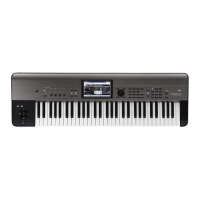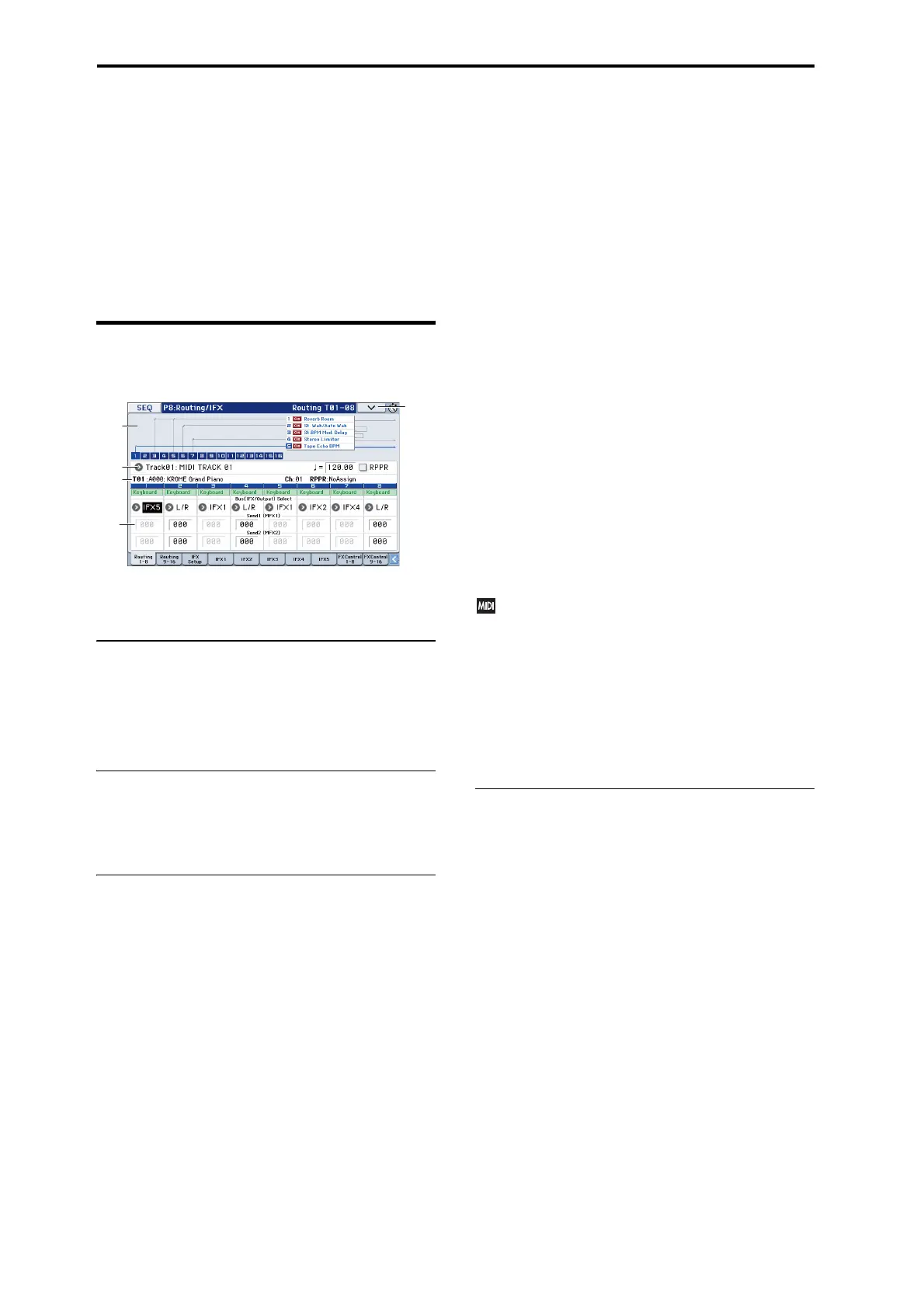Sequencer mode
148
SEQ P8: Routing/IFX (Insert Effect)
You can also specify the bus routing for the program used
by each MIDI track 1–16. For instance, you can:
• Send the output of a track to an insert effect
• Route a sound to an insert effect
• Make detailed settings for insert effects
• Make common LFO settings for effects
For details on Insert Effects, please see “Effect Guide” on
page 235.
8–1: Routing1 T01–08,
8–2: Routing1 T09–16
Specifies the bus to which the program oscillator(s) used by
MIDI tracks 1–8 and 9–16 will be sent. You can also set the
send levels to the master effects from this page.
8–1(2)a: Routing Map
This area shows the insert effect routing (Bus Select), the
name of the assigned effect, the on/off status, chaining, and
the output bus that follows the insert effect. The type of
insert effect, the on/off status, and the chain settings can be
edited in the 8–3: Insert FX Setup page.
8–1(2)b: Track Select, Tempo, RPPR
8–1(2)c: Track Info
For more information, please see “2–1: Trim T01–08, 2–2:
Trim T09–16” on page 123.
8–1(2)d: Routing1
Bus (IFX/Output) Select [DKit, L/R, IFX1...5, Off]
This specifies the output bus for the track program’s
oscillator(s).
L/R: Output to the L/R bus.
IFX1, 2, 3, 4, 5: Output to the IFX1–5 buses.
Off: The track will not be output from the L/R bus, or IFX1–
5 buses. Choose the Off setting if you want the program’s
oscillator output of the track to be connected in series to a
master effect. Use Send1 (to MFX1) and Send2 (to MFX2) to
specify the send levels.
Tip: You can create a wide variety of routings by using each
track’s Bus (IFX/Output) Select and the Chain to and Chain
settings (Seq 8–3b) that follow the insert effect.
DKit: You can select this only if the specified program is a
drum program (Oscillator Mode Drums or Double Drums).
The Bus (IFX/Output) Select, FX Control Bus, Send1, and
Send2 settings (Global 5–5b) for each key of the selected
drum kit will be used. Check this setting if you want to
apply an individual insert effect to each drum instrument.
Tip: In most preloaded drumkits, the drum instruments have
the same Bus (IFX/Output) Select settings according to their
type, as follows.
Snares → IFX1
Kicks → IFX2
Other → IFX3
If you want to edit these routings, use the DrumKit IFX
Patch menu command. For more information, please see
“DrumKit IFX Patch” on page 104.
Send1 (MFX1) [000...127]
Send2 (MFX2) [000...127]
For each track, these parameters set the send level to master
effects 1 and 2. These settings are valid when Bus (IFX/
Output) Select is set to L/R or Off. When IFX 1–5 are
selected, the send levels to master effects 1 and 2 are set by
the Send1 and Send2 parameters of the IFX page, and are
applied after the sound has passed through IFX1–5.
The Send 1 and 2 setting you specify here are used during
playback or recording from the beginning of the song. If you
modify these settings during recording, your changes will
be recorded as performance data; the send amounts will
change accordingly during playback. You can also modify
these settings during playback. However if Send 1 and 2
data has been recorded, the settings will change according
to the recorded data.
If
Status
(Seq 3–1(2)c) is either INT or BTH, CC#93 and
CC #91 can control send 1 and 2 respectively and change
their settings. When you switch songs or return to the
beginning of a song, tracks whose
Status
is EXT, EX2 or
BTH will transmit these settings via MIDI. This data will
be transmitted on the MIDI channel of each track as set
by
MIDI Channel
(Seq 3–1(2)c). The actual send level is
determined by multiplying the value of these parameters
with the send level settings of the program used by the
track (
Send1
and
Send2
, Prog 8–1d). (See Global P1:
MIDI, SEQ Mode “Track MIDI Out” on page 200)
V
8–1(2): Menu Command
•0: Memory Status see p. 163
•1: Exclusive Solo see p. 64
•2: Copy Insert Effect see p. 66
•3: Swap Insert Effect see p. 67
•4: DrumKit IFX Patch see p. 104
•5: FF/REW Speed see p. 164
•6: Set Location (Set Location for Locate Key) see p. 164
•7: Put Effect Setting to Track see p. 184
For more information, please see “Sequencer: Menu
Command” on page 163.
8–1a
8–1d
8–1
Menu
8–1b
8–1c

